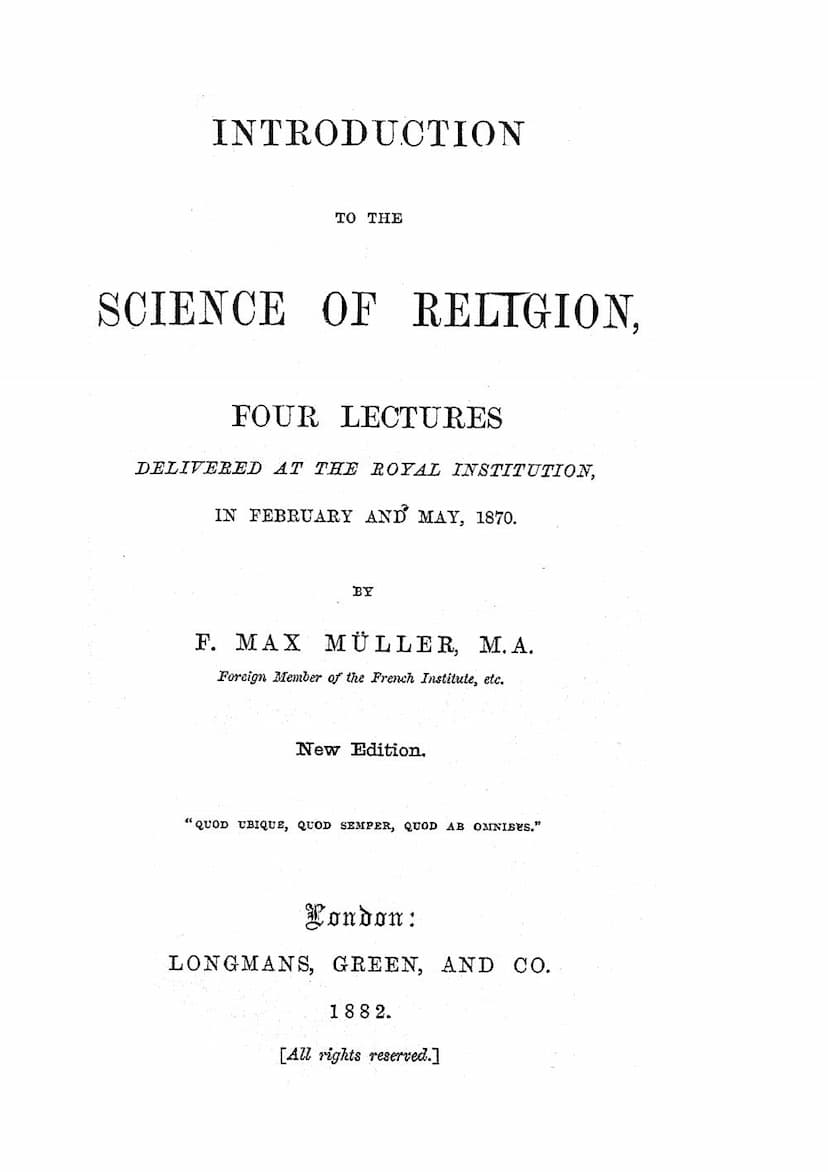Introduction To The Science Of Religion
Added to library: September 1, 2025

Summary
Here's a comprehensive summary of Max Müller's "Introduction to the Science of Religion," based on the provided text:
Overall Aim:
Max Müller's "Introduction to the Science of Religion" is a foundational text arguing for the establishment of the scientific study of religions. He aims to demonstrate that religions, like languages, can be studied objectively, comparatively, and systematically. The lectures address the necessity, methodology, and classification of this emerging field.
Core Arguments and Themes:
-
The Possibility and Necessity of a Science of Religion:
- Müller draws a strong parallel to the "Science of Language." Just as comparative philology revolutionized the understanding of languages, a "Science of Religion" (or Comparative Theology) can do the same for religious studies.
- He acknowledges that religion is a sacred subject and demands reverence, but argues that true reverence comes from fearless and honest inquiry, not from declaring it unfit for scientific treatment.
- He foresees resistance and deep-rooted prejudices but is confident that a scholarly, careful, and reverent approach, guided by evidence, will lead to progress.
-
The Importance of Comparative Study:
- "He who knows one language knows none; he who knows one religion knows none." Comparison is essential for higher knowledge, allowing us to understand the universal principles and underlying structures of both language and religion.
- The comparative method broadens our understanding, enlarges our sympathies, and elevates thought beyond narrow controversies.
-
Defining "Religion":
- Müller distinguishes two meanings of "religion":
- Historical/Canonical Religion: A body of doctrines, traditions, or canonical books (e.g., Christianity, Islam, Brahmanism).
- Inward Faculty of Faith: A fundamental human capacity for apprehending the Infinite, independent of specific historical religions. This "faculty of faith" is what distinguishes humans and is at the root of all religious expression.
- Müller distinguishes two meanings of "religion":
-
The Scientific Method for Studying Religion:
- Materials: Müller emphasizes the vastness of the materials available, including sacred books, commentaries, traditions, inscriptions, proper names, and even the languages themselves.
- Critical Scholarship: He stresses the importance of applying critical methods to original documents, asking questions about authorship, date, sources, and potential biases, much like in the study of languages. This helps distinguish between the founder's original teachings and later developments or corruptions.
- Language as a Key: Müller highlights the intimate connection between language and religion. Understanding ancient languages is crucial for interpreting religious texts accurately and for understanding how religious concepts evolved. He points out how the "petrified language" of ancient traditions can obscure their original meaning.
- Reverence for Primitive Forms: It is essential to understand the most primitive forms of religion before comparing them or assessing their value.
-
Classification of Religions:
- Müller critiques traditional classifications:
- True vs. False: Useless for scientific purposes.
- Revealed vs. Natural: Also problematic because most religions claim revelation, and even revealed religions incorporate elements of natural religion.
- National vs. Individual: Useful but requires critical examination, as "individual" founders often built on existing traditions.
- Polytheistic, Dualistic, Monotheistic: Useful but can group heterogeneous religions, necessitating additional categories like henotheistic and atheistic.
- Proposed Genetic Classification: Müller proposes a classification based on linguistic families, arguing that ancient religions followed similar genetic lines. He identifies three primary centers:
- Turanian: Represented by Chinese, characterized by animism and later a dualistic or philosophical faith (Heaven and Earth).
- Semitic: Characterized by a focus on "God in History" and moral qualities in divine names (e.g., El, Baal, Yahweh).
- Aryan: Characterized by a worship of "God in Nature," with deities often personified natural powers (e.g., Dyaus, Agni).
- He believes these three ancient religious centers developed from a common primitive Aryan, Semitic, and Turanian religion, predating linguistic and national separations.
- Müller critiques traditional classifications:
-
The Role of Mythology and "Irrationality":
- Müller argues that much of the "irrational" or "mythological" element in ancient religions stems from the nature of ancient language, which was more metaphorical and less abstract.
- He advocates for a charitable interpretation, recognizing that these were often attempts to express profound ideas in the limited language of the time.
- He sees mythology not as a disease of language but as an inevitable phase of human thought, particularly in its early development.
- He cautions against judging ancient religions solely by their later, more degenerate or superstitious forms, urging a focus on the founder's intent and the nobler aspects.
-
The Divine Education of Humanity:
- Müller posits that the history of religions can be viewed as a "divine education of the human race," a progressive unfolding of truth over time.
- He rejects the idea that nations before Christianity were utterly abandoned, asserting that all religions contain "grains of truth" and show evidence of divine guidance.
- This perspective is supported by early Christian thinkers like Pope Leo the Great and Irenaeus, who viewed earlier religions as preparations or as suitable for the developmental stage of humanity.
-
Examples and Evidence:
- Müller frequently cites examples from Vedic hymns (Vasishtha's prayers to Varuna, hymns to Agni), Zoroastrian texts (Yasna), Buddhist teachings (Dhammapada), Chinese classics, and ancient Egyptian beliefs to illustrate his points about language, mythology, and religious concepts.
- He also discusses the linguistic evidence for relationships between languages and how this correlates with shared religious concepts among the Aryan, Semitic, and Turanian families.
- His notes and illustrations delve into specific topics like Emperor Akbar's religious syncretism, African languages, Polynesian mythology, the Chinese name for God, Hottentot mythology, and the "Sacred Books of the East" project.
Conclusion:
Müller's "Introduction to the Science of Religion" is a call for a rigorous, interdisciplinary approach to studying religious phenomena. By treating religions scientifically and comparatively, grounded in linguistic analysis and historical criticism, he believes we can gain profound insights into the development of human thought, culture, and spirituality, ultimately fostering greater understanding and reverence for the diverse expressions of religious faith across humanity.